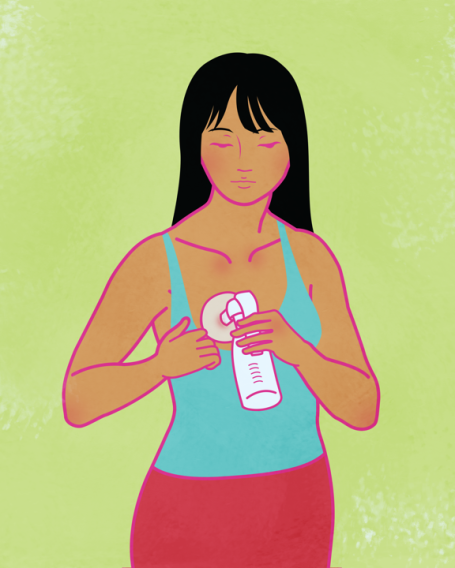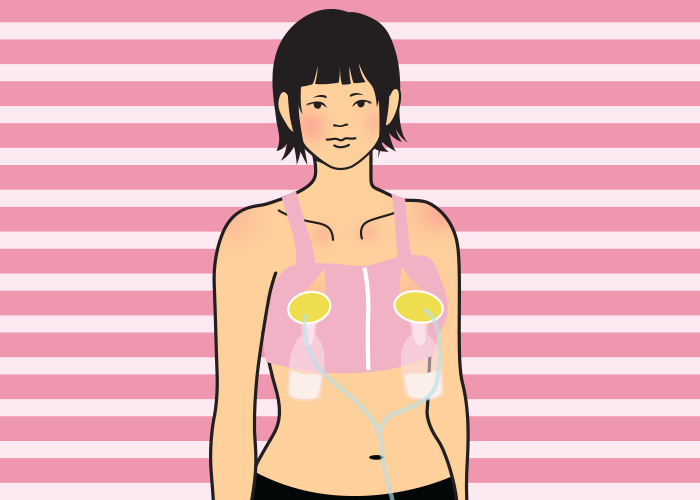Pumping milk. Help for the mother who does not give birth to her baby but wants to breastfeed.
Alyssa Schnell, MS, IBCLC
This third post concludes our mini series about what to expect when breastfeeding a baby you did not give birth to, adapted from Breastfeeding Without Birthing, an essential guide to breastfeeding for mothers through adoption, surrogacy, and other special circumstances.
Using a breast pump is a learned skill. Unlike breastfeeding, it is not natural or instinctual. Responding to your precious baby suckling at your breast, the feel of his downy hair, that new baby smell, his gurgles and coos, and his hands kneading your breasts trigger your milk to flow. Understandably, you may not respond as well to a cold, hard machine. Fortunately, there are tricks to help. No mother finds all of these tips helpful, but I hope that you will find a few that make your pumping experience as successful and positive as possible.

The basics
TIP 1. Rent your pump from a reliable source. Multi-user breast pumps are available for purchase or rental. Due to their expense most mothers choose to rent. These pumps may be available through a variety of sources: lactation consultants, hospital pharmacies, baby boutiques, and drug stores. Your local lactation consultant or breastfeeding counselor can help direct you. Once you’ve got a list of breast-pump rental stations in your area, here are questions you may want to ask before renting:
- Which breast pumps do you rent out? In general, multi-user breast pumps are quality pumps, but it may be helpful to educate yourself about which are available in your area.
- What rental terms are available? The rental terms may be monthly, weekly, or daily.
- What is the rental fee?
- What is the cost of a personal kit? “Multi-user” refers to the motor of the breast pump only; you will still need to purchase your own personal kit to use with the pump.
- How do you test your pumps between renters to ensure they are working properly? Between each user, the rental station should test each breast pump with a suction gauge to ensure that the pump is reaching a suction level of at least -200 mm/Hg, and that the motor is running smoothly and consistently at various settings.
- How do you clean your pumps between users? I have heard stories of mothers renting a pump that came with another mother’s milk splashed all over it—yuck! The pump rental station should wipe down each pump with a disinfectant wipe or cleanser between users.
- Will you show me how to use the pump? You should have access to an instructional manual for your pump, either with your pump or online. Even so, it can be very helpful to have someone experienced with the breast pump show you how to use it the first time. Many of the mothers I work with who are inducing lactation will pick up a breast pump from me on the day they are ready to begin pumping so that the first time they pump, I am there to help.
- Do you carry various sizes and styles of flanges, and can you help fit me with the appropriate flanges? (See tip 2 for more information.)
- What happens if I have any problems with or questions about the pump? If you are having difficulties with your pump, the rental station should offer you prompt and reliable assistance.
TIP 2. Use properly fitting flanges. Flanges, also called breast shields or cups, are the part of the breast pump kit that comes in contact with your breasts. Although your breast pump kit comes with one (or possibly two) flange sizes, several sizes and styles of flanges are available for your multi-user breast pump. (The exception is PJ’s Comfort breast pump by Limerick. This breast pump uses a flexible silicone flange made to accommodate all mothers.) Using a properly fitting flange will maximize your output and comfort from the pump (Kassing, 2002). Many lactation consultants are trained to fit you with flanges.
TIP 3. Optimize pump settings. Even for mothers who have breastfed or pumped for previous babies, inducing lactation with a breast pump can be rough on nipples. Start slowly and gently with short pumping sessions: only about 5 minutes or so. It may also help to use a lower suction level at first. If your breast pump has a separate cycle speed setting, you may find it more comfortable at first to set the cycle speed on your breast pump for faster cycles so that the suction on your nipple is held for just a short time each cycle. Over time, your nipples will be acclimated to the stimulation of the breast pump and you will be able to increase your pumping time to 15 to 20 minutes, raise the suction level, and increase the length of the cycles if that makes the pump more effective for you.
The lack of milk flow can also cause discomfort at first. Some mothers choose to hand express for a couple of weeks in order to initiate milk production and then switch to the breast pump. In addition to being an effective way to jump start milk production, hand expressing for a couple of weeks before pumping is a gentler way to introduce regular nipple stimulation.
Once your nipples are acclimated to the breast pump, find the settings that offer you the most comfort and the most output in the shortest amount of time. Because mothers respond to different stimuli, the pump settings can be different from mother to mother. If the highest comfortable suction level is quite a bit less than the maximum suction level on your pump, this may be an indication that your flanges do not fit properly. Finding the optimal settings for you is a little trickier than it sounds because at first there will be little to no milk. Over time, the amount of milk you produce will increase, and you can make adjustments to the settings if necessary.

TIP 4. Use lubrication as needed. If you have the properly fitted flanges and have found your best settings on the pump but still feel some discomfort, use lubrication. Apply 100% extra virgin olive oil or a commercial nipple cream as a lubricant as needed. Lansinoh brand lanolin is not recommended for this purpose because it is tacky rather than slippery.
TIP 5. Express your milk frequently. For mothers who are exclusively pumping, the key is to simulate the nursing patterns of a baby who is establishing his mother’s milk production. A newborn baby nurses at least 8 to 12 times per day, so it is essential to pump at least 8 times per day on a regular basis. It is important that one of the pumping sessions happens during the middle of the night. Although it is ideal to empty the breast each time you pump, pumping for 5 to 10 minutes is more beneficial than not pumping at all.
Some situations in which you might pump even more often are a “Pumping Holiday” and “Power Pumping,” for no more than a few days at a time. These are both excellent strategies for using pumping frequency to give your milk production a boost. (See Chapter 11, Physical Techniques for Inducing Lactation, for details.)
TIP 6. Pump with one or both hands free. Because you may be pumping very frequently, it can be convenient to have one or both of your hands free while you are pumping. When you first start to pump, you may need to hold the flanges to each breast with one hand each. When you become more comfortable, you may be able to free up one hand by holding the flange on the right breast with your left hand while the left flange is held on with left forearm, leaving your right hand free (or vice-versa if you are left-handed). It is also possible to pump completely hands-free using a hands-free bustier or attachment.

TIP 7. Keep cleaning of collection kit and milk storage simple. For mothers who are pumping many times throughout the day, cleaning the pump collection kit and storing pumped milk after each pumping session is unnecessary. For mothers who are pumping very frequently, or are power pumping, the kit and bottles can sit at a typical room temperature for up to 4 to 6 hours. Aim for 4 hours in warmer temperatures. While the pump kit sits out, cover the kit and bottles with a clean cloth diaper, receiving blanket, or towel. Then, after 4 to 6 hours, the milk can be stored in the refrigerator, the pump collection kit parts are washed, and you are ready to go for the next 4 to 6 hours (Genna, 2009).
Another approach is to detach the pump collection kit and attached bottles from the tubing. Place the pair of kits/bottles in a zippered plastic storage bag in the refrigerator between pumping sessions for up to 12 hours at a time before cleaning the collection kit and storing the expressed milk. Before pumping with refrigerated kit, detach flanges and run under warm water before pumping; applying chilled flanges to the breast can decrease the effectiveness and efficiency of the breast pump (Kent, Geddes, Hepworth, & Hartmann, 2011).
Some mothers find having a second pump-collection kit is worthwhile. One kit is air-drying while the second is in use.
Additional tips
For many mothers, the basic pumping techniques above will give the results you are looking for. If you are one of those lucky mothers, feel free to skip right over this section. However, if you are finding pumping challenging or you are not getting the output you are looking for, listed below are some additional tips.
TIP 8. Use hands-on pumping. Hands-on pumping simply refers to using breast massage during pumping and/or hand expression after pumping. If you are not getting the output you’d like from your pump, hands-on pumping is a very effective method for increasing the amount of milk you express. In one study of mothers of preterm babies, 86% of the mothers found that breast massage during pumping, and hand expression after pumping, increased the amount of milk they were able to express by 93% (Morton et al., 2012). Another study found breast massage (without hand expression) during pumping increased the amount of milk they expressed by 42% (Jones, Dimmock, & Spencer, 2001). Hands-on pumping is described in detail in Chapter 11, Physical Techniques for Inducing Lactation.
TIP 9. Distract yourself. While pumping, do not watch the bottles. Sometimes it helps to throw a receiving blanket over the kit and bottles. An enjoyable activity while pumping (watching a movie, reading, talking on the phone, listening to music or nature sounds) can distract you and take off some of the pressure.
TIP 10. Increase relaxation. You know what helps you to relax. It might be deep breaths, an enjoyable activity, or a scented candle, a hypnosis CD or App that helps you increase your milk production, and pumping output.
TIP 11. Use visualization. It can help to visualize your milk flowing, or a waterfall flowing freely, or whatever image helps you.

TIP 12. Use sensory input. When the baby nurses, a mother receives a lot of sensory input from the baby that helps trigger the milk to flow. For many mothers, using sensory stimuli that remind her of her baby can help while pumping: a picture of her baby, a recording of her baby’s sounds, or the scent of an unwashed baby blanket or piece of clothing.
If your baby hasn’t arrived yet, consider sensory input that makes you think of your baby-to-be. You could pump in your nursery, if you have one. You may have a picture of your baby—even an ultrasound. You could listen to lullabies, or whatever connects you with your baby-to-be.
TIP 13. Boost your oxytocin. Oxytocin is the hormone that causes the milk to eject, also known as let-down. Letting down for a breast pump can be much more difficult than letting down for your baby. In addition to sensory input, try things that boost your oxytocin. Having your partner massage you while you are pumping—between the shoulder blades works especially well—will release oxytocin. Laughter and feelings of romance boost oxytocin. Consider reading books or watching movies that are funny or romantic while you pump. One mother found that simply pumping with her husband in the room increased her milk output!
TIP 14. Apply a warm compress to your breasts before pumping. A warm compress, such as a warm, moist washcloth can help the milk to flow. Or, make a warm compress by filling a tube sock with rice, knotting the open end, and warming in the microwave. Apply to the breasts just before pumping.
My story of pumping to induce lactation
For the 6 weeks before Rosa was due, I pumped 8 times per day, each day producing more milk than the one before. By the time she arrived, I was pumping 15 ounces per day! I believe that my pumping success was due to a combination of factors. First, I rented a breast pump from a local IBCLC in private practice. She showed me how to use the pump and she fit me with the proper flanges. Then, because I knew that we would have a long and intimate relationship, I named my breast pump. (Lucy, if you must know!) I set up my pumping station in the future nursery. It was comfortable and cozy, with a place for a glass of water and a book. Everything about that room connected me with my baby-to-be. My intention was that being in the nursery would also offer privacy. However, by the second day of pumping, my 3rd grader came in to ask for help with his homework. Pumping isn’t very discreet, so I was uncomfortable about an older child witnessing it. But he wasn’t uncomfortable, and in the end I think that it helped that I could make pumping flexible around the other needs of the family.
In addition to all of the ways the nursery connected my senses with my baby, I was surprised to find how strongly I responded to the smell of my own milk. That smell was what I associated with baby smell. At each pumping session, I double pumped for about 15 minutes. Then I stopped pumping to “massage, stroke, shake” to elicit another letdown. I pumped again for another 5 minutes or so. I wanted pumping to be as relaxing and enjoyable as possible, and for me that meant fun books to read while pumping. Reading also distracted me from watching the bottles. Prior to inducing lactation, I was always a mystery reader. Yet, while I was pumping, I preferred funny romantic novels. Hmm … laughter and feelings of romance boost oxytocin, the hormone responsible for milk release. I didn’t use all of the techniques suggested in the chapter, but I found just the right ones for me.

Part 1: Breastfeeding Without Birthing: Making Milk
Part 2: Breastfeeding Without Birthing: Hormones
I hope you have enjoyed this 3-part mini series and found it a useful starting point.
You can read in more detail my book, Breastfeeding Without Birthing. Good luck!
References

Genna, C. W. (2016). Selecting and using breastfeeding tools: Improving care and outcomes.Amarillo, TX: Praeclarus Press.
Jones, E., Dimmock, P. W., & Spencer, S. A. (2001). A randomised controlled trial to compare methods of milk expression after preterm delivery. Archives of Disease in Childhood – Fetal and Neonatal Edition, 85(2), 91F–95. doi:10.1136/fn.85.2.f91
Kassing, D. (2002). Bottle-feeding as a tool to reinforce breastfeeding. Journal of Human Lactation, 18(1), 56–60. doi:10.1177/089033440201800110
Kent, J.C., Geddes, D.T., Hepworth, A.R., & Hartmann, P.E. (2011). Effect of warm breastshields on breast milk pumping. Journal of Human Lactation, 27(4), 331–338. doi:10.1177/0890334411418628
Morton, J., Wong, R. J., Hall, J. Y., Pang, W. W., Lai, C. T., Lui, J., … Rhine, W. D. (2012). Combining hand techniques with electric pumping increases the caloric content of milk in mothers of preterm infants. Journal of Perinatology, 32(10), 791–796. doi:10.1038/jp.2011.195























2 Pingback